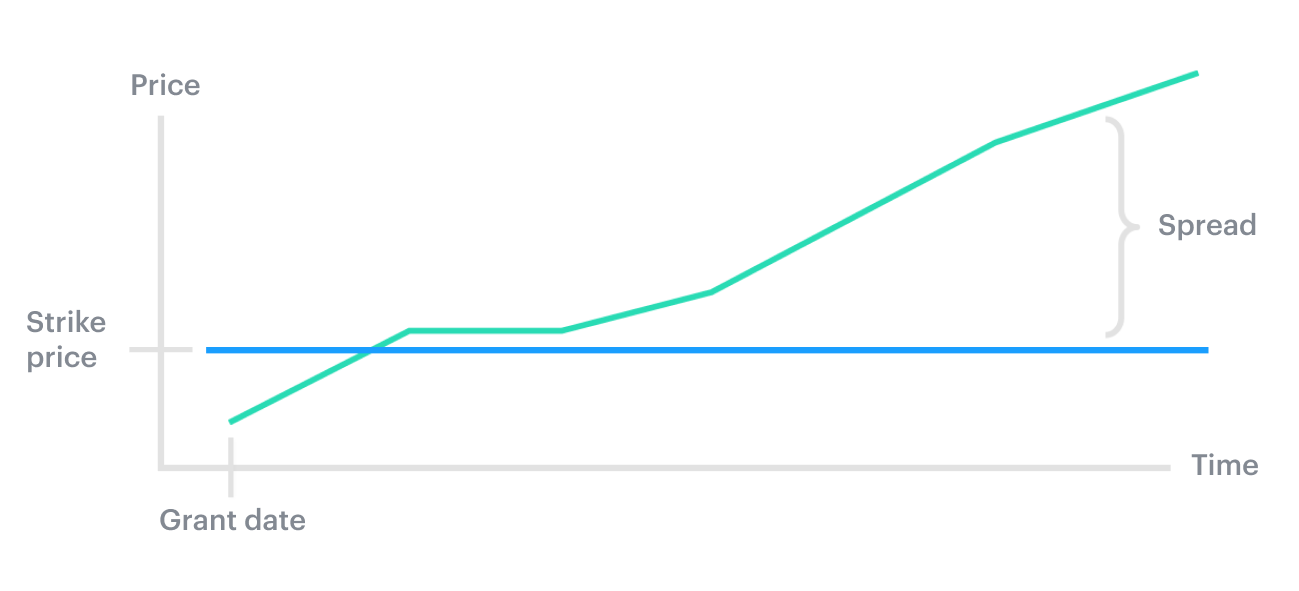There are three main types of stock options companies offer as part of their employee compensation packages: non-qualified stock options (NSOs), incentive stock options (ISOs), and restricted stock units (RSUs). Each equity type is taxed differently by the Internal Revenue Service.
What are non-qualified stock options?
Non-qualified stock options (NSOs) are a type of stock option that does not qualify for favorable tax treatment for the employee. Unlike with incentive stock options (ISOs), where you don’t pay taxes upon exercise, with NSOs you pay taxes both when you exercise the option (purchase shares) and sell those shares.
As with other types of stock options, when you’re granted NSOs, you’re getting the right to buy a set number of company shares at a fixed price, referred to as the strike price, grant price, or exercise price. The strike price of an option is determined by a company’s 409A valuation or fair market value (FMV). If the value of the share increases over time, you may make money on the difference (the spread) between your fixed purchase price and your eventual sale price.

How are non-qualified stock options taxed?
With NSOs, you pay taxes both when you exercise your options and when you sell your shares.
When you exercise
When you exercise your stock options, you will be taxed on the difference between your strike price (fixed purchase price) and the current market price of those stock options. This difference is the spread that we mentioned earlier. Your company will usually withhold ordinary income tax (which includes both payroll taxes and regular income taxes) on the spread when you exercise.
For example, if you exercise 100 vested options at a grant price of $1 and the current value is $2, you’ll pay ordinary income tax on the $100 gain.
When you sell
After you exercise your options, you can either sell right away or hold onto your stock. If you sell right away, you will not experience any capital gain and will only have to pay ordinary income tax on the spread.
If you sell your stocks within a year of when you exercised your options, you’ll pay short-term capital gains tax on any increase in value since the exercise date. But if you hold onto your stocks for more than a year and then sell, you would pay long-term capital gains tax, which is typically a lower rate than the short-term capital gains tax rate.
|
Action |
Tax implication |
|
You exercise your NSOs |
You’ll likely pay ordinary income tax on the difference between your strike price and the current market price of the stock |
|
You exercise and sell your NSOs in one transaction |
You’ll likely pay ordinary income tax on the difference between your strike price and the current market price of the stock |
|
You sell your NSOs within a year of exercising |
You’ll likely pay short-term capital gains taxes on the profit you made selling your options |
|
You sell your NSOs after holding them for at least a year |
You’ll likely pay long-term capital gains taxes on the profit you made selling your options |
When can I exercise non-qualified stock options?
Typically, you gain the ability to exercise your stock options on a set schedule as you work for a company over time. This is called vesting. You can exercise your NSOs as soon as they vest, but you can also choose not to exercise.
If you choose to exercise, you can either pay the strike price in cash or sell a portion of your shares to cover the cost of exercise (referred to as a “cashless” exercise). Check to see if your company allows cashless exercises.
If you leave your company, you’ll usually have a certain amount of time–the post-termination exercise” (PTE) period–to exercise your vested NSOs. If you don’t exercise your options before this period ends, you’ll lose your opportunity to purchase them.
To maximize your potential profit, talk to a tax advisor before exercising and selling your non-qualified stock options. While advisors can’t predict your company’s future stock performance, they can help you understand your next steps and minimize your tax liability.
Help your employees navigate tax decisions
Carta Tax Advisory helps employees make informed decisions about their equity and taxes—powered by Carta’s cap table platform. Learn how you can help educate your team.
This article was originally published on June 21, 2019.






